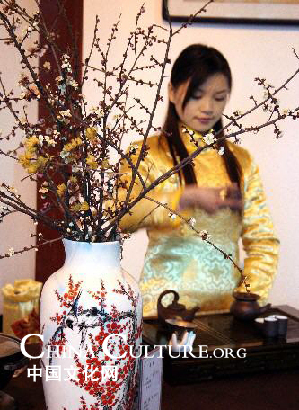Few things are as synonymous in the popular imagination as China and tea, and with excellent reason. Tea drinking in China can be traced back thousands of years, and the humble Camellia sinensis bush continues to be regarded as one of life's basic necessities, right alongside rice, oil and salt.

An Old Habit in a Refined Ambience
Perhaps more importantly, tea is at the center of a multitude of elaborate cultural rituals which are as varied as the many ways the leaves can be brewed, and no self-respecting Chinese host would dream of receiving guests without serving some.
As with any staple, of course, affordability was always a given, and public teahouses were for the most part simple affairs – inexpensive and unpretentious – where ordinary people would meet with friends to pass the time of day. With China's spectacular emergence as an economic powerhouse, however, the teahouse has metamorphosed into a trendy and considerably more lucrative proposition, analogous to the chic cafes so endemic in the West.
Which is why something as simple as a cup of hot water with a few tealeaves in it has suddenly piqued the entrepreneurial interest of China's new business elites. In the first quarter of 2006, for example, the Beijing Administration for Industry and Commerce received over 300 applications for new teahouses, while figures from the China Tea Marketing Association show that the capital had more than 700 teahouses in 2004 – double the number just three years before.
"The year 2000 saw a mushrooming of teahouses," said Yang Chunwu, assistant manager of the Wu Fu Teahouse, the first of the new-style establishments dedicated to promoting Chinese tea culture. "But there has also been an increasing homogeneity of products."
Once, teahouses played a more traditional role – they served as salons for ordinary Beijingers, as noisy trade markets, as rendezvous for clansmen, even as clubs for bird lovers, not to mention as places to eat or get the latest news. When Yin Shengxi, who later established the well-known Lao She Teahouse, sold tea behind a stall in Qianmen Street in 1979, a cup of tea cost only two cents. Now, the average cost for a pot of tea has risen to RMB 50-100, and some teahouses actually charge by the hour.
In early 1994, when Wu Fu had just opened, people did not realize that it was different from traditional teahouses. "How much for a cup?" some old lady would ask as she came in laden with a vegetable basket, and would immediately turn away upon hearing the price. Wu Fu was hard pressed to make ends meet those first few months as it waited patiently for patrons.